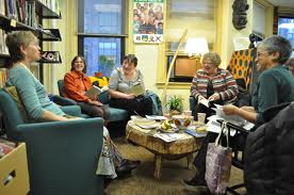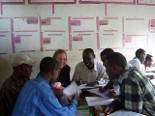Teaching About Africa in Elementary Schools
by Marylee Crofts
Not long ago Ashanti to Zulu won the Caldecott Medal of Honor for Children’s books. I handed it to an eight-year-old child who had lived in Zambia for a year when he was five. He looked at each page, reading about the different groups of people and admiring the illustrations. Then he turned to me and said, “You know, none of these people are wearing glasses, and the army men aren’t carrying rifles and wearing camouflage.” How observant he was! The African people he had met in Zambia were very different from the African people he saw in the book. His real experiences were contradicted by the pictures in Ashanti to Zulu.
This candid comment by a young child raises a central issue in teaching about Africa. Stereotypes of African peoples and cultures pervade many of our perceptions, as well as much of the teaching material we are encouraged to use in our classes.
This beautiful book reinforces our stereotypes of Africans as remote village dwellers, wearing skins, carrying spears and shields, untouched by the technological revolution of the 20th century. Nothing could be further from the truth, but these stereotypes are reinforced daily through movies, television shows, and news media produced by people mired in the same stereotypical ruts.
It is our job, as teachers, to check our own mental pictures of Africa. Are we behind the times and unaware of our own role in perpetuating the stereotypes in the minds of our children? Do we still have the wild animal/jungle/primitive native image ourselves? If so, how can we find ways to present African studies in a manner which breaks this cycle of perpetuating misinformation and distorted images?
Here are some tips to help overcome some of the big problems:
A. Don’t teach about Africa. This diverse and complex continent with over 50 countries, is just too much to cover in an elementary curriculum. Choose one country and do it well. So many children think that Africa itself is a country; too frequently, world geography lessons focus on Japan, China, India and Africa. This juxtaposition of countries with a continent reinforces in children’s minds the misconception of Africa as a country.
Nigeria is one of the best choices for a country study because it is a complex and diverse nation of great importance. Family and communities differ from one part of Nigeria to another. These varying lifestyles can be studied by learning about people who live in the city, both cities of ancient historical origin and those of more recent 20th century development. These life styles may be compared and contrasted with those of people living in small towns, villages, and on farms. Nomadic pastoral life styles are also represented, giving a full and varied spectrum of human patterns of society.
Nigeria also encompasses a variety of geographical areas, from the seacoast forests, through the savannah prairies, to the desert fringe. Further diversity is seen in the range of agricultural products, manufactured goods, and mineral extraction of Nigeria’s diverse economy. For example, do your children know that Nigeria is the number two foreign supplier of oil to the United States?* Nigeria’s importance within Africa and within the global community is great. It is very powerful in political terms; it is a leader among nations in the southern hemisphere.
B. Seek commonalities in the human experience, respect differences, and relate your African studies curriculum to the daily lives of children. First, the human drive for justice and freedom; the love of family and friends; the desire for good health care; opportunity for education and adequate housing; the sadness of suffering from hunger, disease, natural disasters, or the loss of loved one—all of these are basic commonalities shared by peoples in Africa that children need to learn.
In addition, they need to learn that people are different in the ways they express themselves and in their appearance, dress, housing, music, art and dance, and that these differences reflect the variety and richness of human beings. Frequently, teachers emphasize human differences when teaching about Africa because the children show an interest in lessons about exotic or “weird” people. This is certainly not what we mean by cultivating a respect for human differences. This plays upon the we/they theory of superior/inferior cultures and in no way builds understanding of African peoples.
Let the children discover the many cultural and economic linkages between the United States and Africa. Many third graders are surprised to learn that their chocolate candy bars are made with cocoa beans, an important export of many West African countries. Few children have been encouraged to appreciate the influence of African music on American music, in the Caribbean and in the United States. Hundreds of linkages between Africans and Afro-Americans and between the United States and African countries may be discovered through connections of churches, businesses, political and professional organizations, and others.
C. Reinforce the ideas you have taught in other segments of the curriculum by giving examples and illustrations in an African studies unit. For instance, if you study the sources and uses of water as suggested in this booklet, you can reinforce the concepts you have worked on by applying them to the African studies unit.
D. African studies must not be dominated by problems. Undue emphasis on disease, malnutrition, drought, political oppression, the lack of technological development, illiteracy, etc., will lead children to conclude that they would never want to go to Africa. They are likely to become afraid and repulsed by these thoughts.
If, on the other hand, children are taught constructive and positive aspects and developments in African history and contemporary life, the children will say, as many have said in their marvelously illustrated letters to us, “I learned a lot about your country and I’d like to go there some day.” They learned about new foods, new clothing styles, new songs and games. They also learn of the achievements of African nations in providing clinics and hospitals for people who never had access to such services under the colonial system.
In the new wave of global education, too much emphasis is placed on human problems-the energy crisis, water pollution, overpopulation and underproduction. Children need to learn about these major crises in order to respond in an effective way, but there is a danger of creating an attitude of despair and hopelessness if young children are over-exposed to problems and underexposed to human development. We have an opportunity to correct this trend when we teach about the nations of Africa.
E. Teach the idea that we have something to learn from African societies. In the area of conflict resolution, children might study ways in which some Zimbabwean communities treat thieves and other deviants. The following case study might be acted out by children and may serve as a model for future conflict resolution within the class.
Suppose that farmer X is accused of stealing some bags of grain from farmer Y. Hard feelings and mistrust, harsh words and accusations are expressed. The head of the village calls together farmer X and farmer Y, along with their families and other interested or involved persons. Everyone in turn gives his or her version of the story. Each of the extenuating circumstances is examined. Did farmer Y ever in the past insult or injure farmer X? Are their wives on friendly terms? Have their children quarreled? Did any other events or circumstances influence farmer X’s actions?
After everything is aired, the community leader impartially summarizes the case and seeks the consensus of the group. Farmers X and Y shake hands. Farmer X returns the grain or something of equal value to Y. Farmer Y then gives X a gift as a symbol of his acceptance of the resolution. Reconciliation and restoration of the community are the aims of the judicial system, for the sake of the individuals and of the entire community.
As elementary and middle school pupils understand this view of the sanctity of the individual and the emphasis on the interconnection of all peoples, they may glimpse (1) the complexity of these so called “simple societies,” (2) the humanity and concern for justice in peoples who are often stereotyped as “primitive, hostile, and savage,” and (3) the contributions to other societies that these African peoples and their institutions may be able to make.
Teaching about Africa in elementary and middle schools gives us an exciting opportunity to begin the process of critical thinking and the examination of presuppositions. Learning really makes a difference in African studies. We are not adding to our accumulated knowledge about Africa; we are completely revamping our ideas: we are discarding the stereotypes; we are learning together that what we do in school can make a difference in what we think.
* 1992 revised figures: Nigeria is the fourth largest supplier of oil to the U.S.
(1993)
Reprinted From:
Helping Boys and Girls Discover the World
Teaching About Global Concerns and the United Nations in Elementary and Middle Schools
Leonard S. Kenworthy, Editor
UNA/USA and UNESCO Associated Schools, 1978
For information about additional resources, please contact:
Barbara B. Brown, Outreach Director
Africa in the School and Community
Boston University
232 Bay State Road
Boston, MA 02215 617-353-7303 or 617-353-3673
NOTE: I endorse the 5 points (A-E) in this article. However, I would suggest modifying the first point (A): I believe it is appropriate to teach about Africa as an introduction to a unit. Given the enormous diversity of the continent, I recommend that classes focus on one country (or two if time permits). Countries with especially good teaching resources are Egypt, Kenya, Ghana, Nigeria, Senegal, and South Africa.
Barbara B. Brown, Outreach Director
Africa in the School and Community
Boston University


